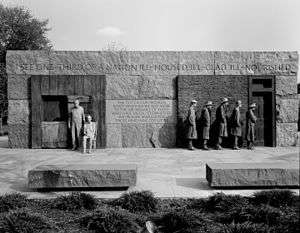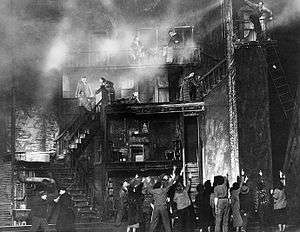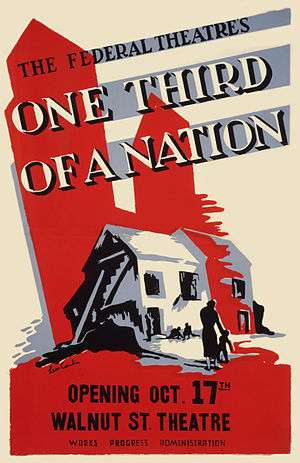One-Third of a Nation

One Third of a Nation is a Living Newspaper play produced by the Federal Theatre Project in 1938. Written by Arthur Arent from research by the editorial staff of the Federal Theatre Project, it focused on the problem of housing in the United States and the growth of slums in New York City. The play was produced in New York and in nine additional cities, where it was adapted to specific community conditions. It was adapted as a feature film in 1939, and revived on the New York stage in 2011.
Plot summary

I see one-third of a nation ill-housed, ill-clad, ill-nourished. … The test of our progress is not whether we add more to the abundance of those who have much; it is whether we provide enough for those who have too little.
One-Third of a Nation opens with a scene depicting a burning tenement in New York. The Voice of the Living Newspaper pairs with a character named Angus Buttonkooper, “the little man”, and they both try to explain why decent housing is not available in New York. Their discussions lead them to the basic problem of corruption in the New York housing department.
With the expansion of the city, a rich landlord is depicted sitting on a patch of grass, which portrays his property. As the population of the city expands, more and more people try and fit on that patch of grass. They resort to petty fighting and theft to somehow get a place to squat on and get rid of their “dehumanizing misery.” Slowly but steadily, the little man gets politicized over the 100 years of corruption and troubles presented in the play, increasingly becoming impatient and frustrated by the polarity between the wealthy landlord and their impoverished tenants.
The piece ends with the delineation of the failure of the Housing Act of 1937, a $565 million project that only managed to alleviate about two percent of New York’s slums. The Little Man and his wife vow to continue to diatribe the government until the housing crisis is resolved and “everyone in America has a decent place to live in."[2]
One-Third of a Nation employs the concept of the little man, an ordinary person with little or no power over his surroundings. The little man is an impoverished person with little access to resources, always suppressed by big men that are capitalists or landlords. The play presents him as travelling through 100 years, witnessing corruption and ill administration throughout his journey. The little man emerges as the protagonist and plays a vital role in fulfilling the Living Newspaper’s function as a social commentary.
In a technique characteristic of Living Newspapers, direct communication with the audience, the play concludes with the little man urging the audience to take action and press the government to introduce reforms in housing.
Production

Written by Arthur Arent from research by the editorial staff of the Federal Theatre Project, One-Third of a Nation was first presented January 17–October 22, 1938, at the Adelphi Theatre in New York.[3] One of the greatest successes of the New York City Federal Theatre Project, it was seen by more than 217,000 people in that city alone.[4]:217
Designed by Howard Bay, the New York production filled the stage with a huge cross-section of a slum that was burned each evening.[4]:217
Adapted to match specific local housing conditions, the play was presented in nine additional cities[4]:216, 390 including Cincinnati, Detroit, Hartford, Philadelphia, Portland and Seattle.[4]:216 One-Third of a Nation was presented daily at the Golden Gate International Exposition[4]:291–292 and was still running in San Francisco when the Federal Theatre Project ended July 1, 1939.[4]:216
Reception

"The press throughout the country considered One-Third of a Nation the most important contribution to date," wrote Federal Theatre Project national director Hallie Flanagan.[4]:216
The first success of the New Orleans Federal Theatre, One-Third of a Nation was praised by The Times-Picayune for being "as timely and shrewdly staged theatrical entertainment as has been witnessed in New Orleans for many a season." The New Orleans Item called it "a dramatic bombshell … a startled initiation into the roaring effectiveness of a new stage medium."[4]:86–87
The Cincinnati Post called it "one of those rare things in the theatre: a play which makes an important subject tremendously exciting."[4]:216 The Oregon Journal described it as "topical, rapidly paced, and brilliantly experimental."[4]:301 In Detroit the play was held over for four weeks. "The worst thing about One-Third of a Nation is that it is true," wrote The Detroit News, which praised its "unforgettable vividness and compelling power … thrilling beyond description … a rare experience in the theatre — not to be missed by anyone."[4]:217
While withholding praise during the nine-week run of One-Third of a Nation in Seattle, The Seattle Times reported, "Seldom has any play so caught the public fancy."[4]:217 A Philadelphia reviewer criticized the number of people in the cast — missing the point that employment was the reason the Federal Theatre existed — but still granted that the production "frequently smacks you between the eyes with its dramatic force. If you're interested in stagecraft or housing, it's an experiment worth your money."[4]:217
Criticism in Congress
"One-Third of a Nation, like any powerful play on a controversial subject, made enemies as well as friends," wrote Flanagan. "Enemies made by the living newspaper were, I believe, powerful enemies, instrumental in the final closing of the project."[4]:220–221
One-Third of a Nation was one of the Federal Theatre Project productions criticized by conservatives in Congress.[4]:217 Funding for the Federal Theatre Project was terminated in 1939 after strong Congressional objections to the left-wing political tone of less than 10 percent of its productions.[4]:361–363
Adaptations
One-Third of a Nation was adapted for a 1939 film released by Paramount Pictures, produced and directed by Dudley Murphy. The cast includes Sylvia Sydney, Leif Erickson, Myron McCormick, Hiram Sherman and 15-year-old Sidney Lumet in his only screen performance as an actor. It was the first Federal Theatre Project play to be sold to the film industry.[5] The $5,000 fee was given to the Guild Committee for Federal Writers' Publications, a non-profit organization that included Heywood Broun, Franklin P. Adams and Lewis Mumford, among others. The play was published by Random House in 1938.[4]:218
Paramount's 1939 film was released on Region 0 DVD-R by Alpha Video on September 1, 2015.[6]
Revival
One-Third of a Nation was revived in 2011 by the Metropolitan Playhouse in New York City. "Part history lesson, part protest, the play uses a series of sketches to dramatize ghastly housing conditions and to condemn corruption, speculators and slumlords," wrote The New York Times. "Much of the script remains fresh, with a wry, invisible narrator and characters who step out of scenes to comment on the action, which traverses more than 200 years."[7]
"Though full of carefully researched facts and figures and more than 120 characters, this presentational and frankly political drama bursts with life as it examines the history of New York City real estate and the social and health problems stemming from the slums," wrote Backstage. "A nimble cast of 11 (the original had 25) delivers the show's still-relevant message — that everyone deserves a decent and affordable place to live — with force and conviction."[8]
References
- ↑ "FDR's Second Inaugural Address, January 20, 1937". Franklin D. Roosevelt Four Freedoms Park. Four Freedoms Park Conservancy. Retrieved 2015-02-28.
- ↑ Gothu, Sarah (2009). "Living Newspapers: One Third of a Nation". The Great Depression in Washington State; Pacific and Northwest Labor and Civil Rights Projects. University of Washington. Retrieved 2015-02-28.
- ↑ "One-Third of a Nation". Internet Broadway Database. Retrieved 2015-02-28.
- 1 2 3 4 5 6 7 8 9 10 11 12 13 14 15 16 17 Flanagan, Hallie (1965). Arena: The History of the Federal Theatre. New York: Benjamin Blom, reprint edition [1940]. OCLC 855945294.
- ↑ "One Third of a Nation". AFI Catalog of Feature Films. Retrieved 2015-02-28.
- ↑ "Alpha Video - One-Third of a Nataion". Retrieved 2015-08-24.
- ↑ Jaworowski, Ken (May 1, 2011). "A Depression-Era Protest Ripped From the Headlines". The New York Times. Retrieved 2015-02-28.
- ↑ Haagensen, Erik (May 2, 2011). "One-Third of a Nation". Backstage. Retrieved 2015-02-28.
External links
- Playscript for One-Third of a Nation, Federal Theatre Project Materials Collection, George Mason University
- One-Third of a Nation at Metropolitan Playhouse, New York, April 23–May 22, 2011
- One-Third of a Nation at Turner Classic Movies